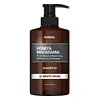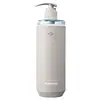What's inside
What's inside
 Key Ingredients
Key Ingredients

No key ingredients
 Benefits
Benefits

 Concerns
Concerns

 Ingredients Side-by-side
Ingredients Side-by-side

Water
Skin ConditioningSodium Cocoyl Alaninate
Lauryl Hydroxysultaine
CleansingLauryl Glucoside
CleansingSodium Cocoyl Isethionate
CleansingErythritol
HumectantGlycerin
HumectantSodium Methyl Cocoyl Taurate
CleansingHoney Extract
HumectantMacadamia Ternifolia Seed Extract
EmollientSesamum Indicum Seed Extract
Skin ConditioningOenothera Biennis Flower Extract
AstringentGlycine Soja Seed Extract
Skin ConditioningVaccinium Angustifolium Fruit Extract
Skin ProtectingUndaria Pinnatifida Extract
Skin ConditioningFragaria Chiloensis Fruit Extract
Skin ConditioningMorus Alba Root Extract
BleachingCornus Officinalis Fruit Extract
Skin ConditioningTaraxacum Officinale Leaf Extract
Skin ConditioningRubus Fruticosus Fruit Extract
AstringentOryza Sativa Extract
AbsorbentNelumbo Nucifera Flower Extract
Skin ConditioningAngelica Gigas Root Extract
Skin ConditioningRosa Centifolia Flower Extract
AstringentHibiscus Sabdariffa Flower Extract
Skin ConditioningCamellia Sinensis Leaf Extract
AntimicrobialUlmus Davidiana Root Extract
Skin ConditioningLavandula Angustifolia Flower Extract
CleansingMelissa Officinalis Leaf Extract
Skin ConditioningChamomilla Recutita Flower Extract
MaskingCentella Asiatica Extract
CleansingPelargonium Graveolens Extract
MaskingOriganum Vulgare Leaf Extract
Skin ConditioningEucalyptus Globulus Leaf Extract
PerfumingPanax Ginseng Root Extract
EmollientRehmannia Chinensis Root Extract
Skin ConditioningPueraria Lobata Root Extract
HumectantThymus Vulgaris Extract
PerfumingMelaleuca Alternifolia Leaf Extract
PerfumingMentha Piperita Leaf Extract
Skin ConditioningGlycyrrhiza Uralensis Root Extract
Skin ConditioningRosmarinus Officinalis Leaf Extract
AntimicrobialScutellaria Baicalensis Root Extract
AstringentSaccharomyces Cerevisiae Extract
Skin ConditioningLaminaria Japonica Extract
Skin ProtectingSalicornia Herbacea Extract
Skin ConditioningBrassica Napus Extract
Skin ConditioningNarcissus Pseudo-Narcissus Flower Extract
Skin ConditioningPinus Palustris Leaf Extract
TonicPolygonum Cuspidatum Root Extract
AntioxidantDiospyros Kaki Fruit Extract
Skin ConditioningCamellia Japonica Leaf Extract
Skin ConditioningCeratonia Siliqua Fruit Extract
MaskingArgania Spinosa Kernel Oil
EmollientSimmondsia Chinensis Seed Oil
EmollientCocos Nucifera Oil
MaskingPersea Gratissima Oil
Skin ConditioningMacadamia Ternifolia Seed Oil
EmollientButyrospermum Parkii Butter
Skin ConditioningGuar Hydroxypropyltrimonium Chloride
Skin ConditioningPolyquaternium-10
Sodium Chloride
MaskingBetaine
HumectantAllantoin
Skin ConditioningPanthenol
Skin ConditioningArginine
MaskingSodium Gluconate
Skin ConditioningCitric Acid
BufferingCoconut Acid
CleansingSodium Isethionate
CleansingButylene Glycol
HumectantDipropylene Glycol
HumectantDipotassium Glycyrrhizate
Humectant1,2-Hexanediol
Skin ConditioningEthylhexylglycerin
Skin ConditioningHydroxyacetophenone
AntioxidantCaprylyl Glycol
EmollientParfum
MaskingWater, Sodium Cocoyl Alaninate, Lauryl Hydroxysultaine, Lauryl Glucoside, Sodium Cocoyl Isethionate, Erythritol, Glycerin, Sodium Methyl Cocoyl Taurate, Honey Extract, Macadamia Ternifolia Seed Extract, Sesamum Indicum Seed Extract, Oenothera Biennis Flower Extract, Glycine Soja Seed Extract, Vaccinium Angustifolium Fruit Extract, Undaria Pinnatifida Extract, Fragaria Chiloensis Fruit Extract, Morus Alba Root Extract, Cornus Officinalis Fruit Extract, Taraxacum Officinale Leaf Extract, Rubus Fruticosus Fruit Extract, Oryza Sativa Extract, Nelumbo Nucifera Flower Extract, Angelica Gigas Root Extract, Rosa Centifolia Flower Extract, Hibiscus Sabdariffa Flower Extract, Camellia Sinensis Leaf Extract, Ulmus Davidiana Root Extract, Lavandula Angustifolia Flower Extract, Melissa Officinalis Leaf Extract, Chamomilla Recutita Flower Extract, Centella Asiatica Extract, Pelargonium Graveolens Extract, Origanum Vulgare Leaf Extract, Eucalyptus Globulus Leaf Extract, Panax Ginseng Root Extract, Rehmannia Chinensis Root Extract, Pueraria Lobata Root Extract, Thymus Vulgaris Extract, Melaleuca Alternifolia Leaf Extract, Mentha Piperita Leaf Extract, Glycyrrhiza Uralensis Root Extract, Rosmarinus Officinalis Leaf Extract, Scutellaria Baicalensis Root Extract, Saccharomyces Cerevisiae Extract, Laminaria Japonica Extract, Salicornia Herbacea Extract, Brassica Napus Extract, Narcissus Pseudo-Narcissus Flower Extract, Pinus Palustris Leaf Extract, Polygonum Cuspidatum Root Extract, Diospyros Kaki Fruit Extract, Camellia Japonica Leaf Extract, Ceratonia Siliqua Fruit Extract, Argania Spinosa Kernel Oil, Simmondsia Chinensis Seed Oil, Cocos Nucifera Oil, Persea Gratissima Oil, Macadamia Ternifolia Seed Oil, Butyrospermum Parkii Butter, Guar Hydroxypropyltrimonium Chloride, Polyquaternium-10, Sodium Chloride, Betaine, Allantoin, Panthenol, Arginine, Sodium Gluconate, Citric Acid, Coconut Acid, Sodium Isethionate, Butylene Glycol, Dipropylene Glycol, Dipotassium Glycyrrhizate, 1,2-Hexanediol, Ethylhexylglycerin, Hydroxyacetophenone, Caprylyl Glycol, Parfum
Water
Skin ConditioningSodium Taurine Cocoyl Methyltaurate
CleansingLauryl Hydroxysultaine
CleansingCocamide Methyl Mea
Cocoyl Methyl Beta-Alanine
Skin ConditioningSaccharomyces/Rice Ferment Lipids
Skin ConditioningOryza Sativa Lees Extract
Skin ConditioningMelaleuca Alternifolia Leaf Extract
PerfumingZanthoxylum Piperitum Fruit Extract
Skin ConditioningAnthemis Nobilis Flower Extract
MaskingHydrolyzed Corn Starch
HumectantDimethyl Lauroyl Lysine
Skin ConditioningHoney
HumectantCoconut Acid
CleansingPropanediol
SolventPolyquaternium-10
PPG-3 Caprylyl Ether
SolventZinc Chloride
AntimicrobialButylene Glycol
HumectantParfum
MaskingCitric Acid
BufferingDisodium EDTA
Sodium Benzoate
MaskingPhenoxyethanol
PreservativeDipotassium Glycyrrhizate
HumectantLarix Kaempferi Root Bark Extract
Skin ConditioningCorydalis Ambigua Bark/Root Extract
Skin ConditioningGlycyrrhetinic Acid
Skin ConditioningWater, Sodium Taurine Cocoyl Methyltaurate, Lauryl Hydroxysultaine, Cocamide Methyl Mea, Cocoyl Methyl Beta-Alanine, Saccharomyces/Rice Ferment Lipids, Oryza Sativa Lees Extract, Melaleuca Alternifolia Leaf Extract, Zanthoxylum Piperitum Fruit Extract, Anthemis Nobilis Flower Extract, Hydrolyzed Corn Starch, Dimethyl Lauroyl Lysine, Honey, Coconut Acid, Propanediol, Polyquaternium-10, PPG-3 Caprylyl Ether, Zinc Chloride, Butylene Glycol, Parfum, Citric Acid, Disodium EDTA, Sodium Benzoate, Phenoxyethanol, Dipotassium Glycyrrhizate, Larix Kaempferi Root Bark Extract, Corydalis Ambigua Bark/Root Extract, Glycyrrhetinic Acid
 Reviews
Reviews

Ingredients Explained
These ingredients are found in both products.
Ingredients higher up in an ingredient list are typically present in a larger amount.
Butylene Glycol (or BG) is used within cosmetic products for a few different reasons:
Overall, Butylene Glycol is a safe and well-rounded ingredient that works well with other ingredients.
Though this ingredient works well with most skin types, some people with sensitive skin may experience a reaction such as allergic rashes, closed comedones, or itchiness.
Learn more about Butylene GlycolCitric Acid is an alpha hydroxy acid (AHA) naturally found in citrus fruits like oranges, lemons, and limes.
Like other AHAs, citric acid can exfoliate skin by breaking down the bonds that hold dead skin cells together. This helps reveal smoother and brighter skin underneath.
However, this exfoliating effect only happens at high concentrations (20%) which can be hard to find in cosmetic products.
Due to this, citric acid is usually included in small amounts as a pH adjuster. This helps keep products slightly more acidic and compatible with skin's natural pH.
In skincare formulas, citric acid can:
While it can provide some skin benefits, research shows lactic acid and glycolic acid are generally more effective and less irritating exfoliants.
Most citric acid used in skincare today is made by fermenting sugars (usually from molasses). This synthetic version is identical to the natural citrus form but easier to stabilize and use in formulations.
Read more about some other popular AHA's here:
Learn more about Citric AcidCoconut Acid isn't fungal acne safe.
Dipotassium Glycyrrhizate comes from licorice root.
Extracts of licorice have demonstrated to have antibacterial, anti‐inflammatory, antiviral, antioxidant properties.
One component, glabridin, has extra potent antioxidant and soothing properties. It has also been found to block pigmentation from UVB rays in guinea pigs.
Licorice Root also contains a flavonoid. Flavonoids are a natural substance from in plants. Flavonoids also have antioxidant properties.
Another component, glycyrrhizin, has been found to have anti-inflammatory and antimicrobial benefits. This may make licorice root extract effective at treating acne. However, more research is needed to support this.
Liquiritin is one of the flavone compounds found in licorice. It has been found to help lighten skin by preventing tyrosinase from reacting with tyrosine. When the two react, protein is converted to melanin. Melanin is the substance in your body that gives your features pigmentation.
Licorice root is native to Southern Europe and Asia. It has been used in traditional Chinese medicine to help with respiratory issues.
Learn more about Dipotassium GlycyrrhizateWe don't have a description for Lauryl Hydroxysultaine yet.
Melaleuca Alternifolia Leaf Extract comes from the Tea Tree, Melaleuca alternifolia, Myrtaceae. This tea tree is native to Australia.
Tea Leaf extract contains antimicrobial and anti-acne properties.
This ingredient has perfuming properties and contains linalool and limonene. These fragrance and terpinen components can cause skin sensitivity.
Learn more about the benefits of Tea Tree Oil here.
Learn more about Melaleuca Alternifolia Leaf ExtractParfum is a catch-all term for an ingredient or more that is used to give a scent to products.
Also called "fragrance", this ingredient can be a blend of hundreds of chemicals or plant oils. This means every product with "fragrance" or "parfum" in the ingredients list is a different mixture.
For instance, Habanolide is a proprietary trade name for a specific aroma chemical. When used as a fragrance ingredient in cosmetics, most aroma chemicals fall under the broad labeling category of “FRAGRANCE” or “PARFUM” according to EU and US regulations.
The term 'parfum' or 'fragrance' is not regulated in many countries. In many cases, it is up to the brand to define this term.
For instance, many brands choose to label themselves as "fragrance-free" because they are not using synthetic fragrances. However, their products may still contain ingredients such as essential oils that are considered a fragrance by INCI standards.
One example is Calendula flower extract. Calendula is an essential oil that still imparts a scent or 'fragrance'.
Depending on the blend, the ingredients in the mixture can cause allergies and sensitivities on the skin. Some ingredients that are known EU allergens include linalool and citronellol.
Parfum can also be used to mask or cover an unpleasant scent.
The bottom line is: not all fragrances/parfum/ingredients are created equally. If you are worried about fragrances, we recommend taking a closer look at an ingredient. And of course, we always recommend speaking with a professional.
Learn more about ParfumPolyquaternium-10 is an ammonium salt of hydroxyethylcellulose. It is a white and granular powder used as a film-former and anti-static agent.
This ingredient is commonly found in hair conditioning products. According to a manufacturer, its positive charge makes it great for absorbing hair proteins. The manufacturer also states this ingredient helps with curl retention.
For haircare friends: this ingredient is not a silicone.
Learn more about Polyquaternium-10Water. It's the most common cosmetic ingredient of all. You'll usually see it at the top of ingredient lists, meaning that it makes up the largest part of the product.
So why is it so popular? Water most often acts as a solvent - this means that it helps dissolve other ingredients into the formulation.
You'll also recognize water as that liquid we all need to stay alive. If you see this, drink a glass of water. Stay hydrated!
Learn more about Water